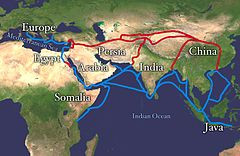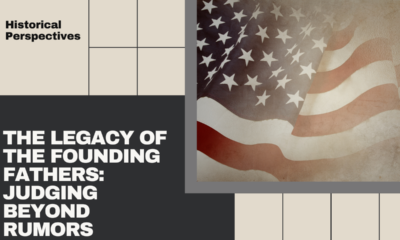Human Interest
Silk Road notes 3: glass

These notes on the Silk Road exhibit at the Cleveland Museum of Natural History continue with a discussion of glass and ceramics. Again the exhibit gives a false impression: that glassmaking and pottery began, or at least were most closely associated, with Islam.
Glass and ceramics along the Silk Road
EXHIBIT SIGN:
FROM WEST TO EAST
Bottle: The Chinese artist who made this porcelain vase borrowed a shape from imported Islamic glassware.
Green Vase: Markets of the Middle East did a brisk business selling Chinese ceramics colored with the pale green glaze known as celadon.
Bowl: In the 1100s, Islamic craftsmen developed a fine-textured clay by mixing crushed quartz with small amounts of ground-up glaze and natural white clay. The resulting pottery, known as fritware, was snow-white, like porcelain. Potters decorated it with brightly colored glass, like the green, yellow and brown shown here.
WHAT WASN’T SAID:
- That glassmaking originated with the Jewish people, a secret maintained for the next 3,000 years.
- That it had been considered an Egyptian discovery until it was finally realized that it could not have originated in a desert. Acceptance of the truth of its origin came in 1983.
FACTS
THE HISTORY OF GLASSMAKING
[ezadsense midpost]
- The art of glassmaking was born in Akkadia, the Biblical Shinar, home of the tribe of Terach, father of Abraham, about 2400 B.C.E. It was a Semitic, and then Jewish, art for the next three millennia. Unique among the arts, glassmaking was invented only once in all of human history and its spread was parallel and coincident with the dispersal of the Jews.
- Manufactured glass was discovered by Dr. R. H. Hall on an archaeological expedition near the ancient city of Eridu, close to Ur, Abraham’s purported birthplace, in the winter of 1918-19. “Only one object of great interest has been found,” reported the astounded Hall, “… In the rubbish beneath the pavement was found a lump of opaque blue vitreous paste which I recognized as true glass… the most ancient piece of glass known.” The object’s date was fixed at between 2047-2038 B.C.E. Later, Akkadian glass, more than two centuries older, was found from buildings and cemeteries of the ancient city of Ur itself.
- Until then, museums and texts on glass-making history cited Egypt as the birthplace of the art. However, glassmaking depends on thick forests for fuel, and could not have been born in a desert; several tons of wood were burned to produce just one kilogram of glass! Where were the forests in Upper Egypt? Further, glass is liquefied silicate stone (quartz), and only a reverberatory furnace (absent from ancient Egypt technology) could achieve and maintain the necessary temperatures of 1200 degrees Celsius temperatures. Glassware couldn’t suddenly appear in 1500 BCE in 18th Dynasty tombs without a trace of hundreds of years of necessary development. Finally, there is no word for “glass” in Egyptian language; scribes used the Akkadian term!
- It was not until 1968 that Dr. Donald B. Harden, author of the catalogue of the British Museum’s collection of Greek and Roman Glass, obliquely accepted the “Asian origin for glass.” In 1983, Dr. Harden finally removed all doubt, admitting, “During my two years at Ann Arbor and the next winter season on the excavating staff in Egypt, I naturally became too Egypto-oriented.”
- Once manufactured, glass is easily melted and reformed into glassware. Since it was not feasible to ship delicate glassware, beads or amulets were exportable. A Canaanite merchant vessel was found off the Turkish coast at the turn of the 14th century,, with tons of cargo of glass ingots and eye-beads. Glass was produced in Israel and Judah (the secret held for 3,000 years) and transported by Canaanites, whom Greeks called Phoenicians – “purple,” from the purple-stained hands and clothes of those who made purple dye.
- Egyptians and Greeks made advances in glassmaking; Romans brought glass into everyday life by making it transparent at a lower temperature. They manufactured in bulk and transported throughout the Roman Empire via their vast trading infrastructure. The Roman love of glass evolved into the glass window, providing protection from the elements while delivering light. They developed the mirror at a lower cost, increasing effectiveness and longevity.
- Roman innovation developed into glassblowing to produce delicate creative shapes, and into clear drinking vessels, for color, transparency and wine clarity.
EXHIBIT SIGN:
A Magnificent Exchange
Islamic merchants who traveled by sea helped ideas flow as they traded glass and other goods for decorated Chinese ceramics. In Arab and Persian households, clay pots with colorful glazes and fine white porcelain from Chinese kilns were especially prized. Over time, potters in both China and the Middle East developed new styles and techniques in response to the overseas trade.
WHAT WASN’T SAID:
- That Muslims were neither the first nor the only merchants to travel the seas.
- That the Mediterranean Jews were responsible for opening up these trade routes.
FACTS:
- Mediterranean Jews were entrepreneurs who controlled much of the trade in the region and developed the economies of those nations, which included Alexandria’s shipping; Syria’s markets; Beirut’s silk production industry and textile dyeing; and the glass factories, with bead shapes and coloration that are traced to Near Eastern Jewish glass designs. The Khazar king and subjects converted to Judaism and went into the Danube basin.
- One thousand seven hundred years before Marco Polo set out on his journey from Venice to China, Persian/Jewish traders pioneered the route from the Near East to Kaifeng, then the Capitol of Imperial China.
- Interestingly, a saying that is attributed to Marco Polo is: ”The militant Muslim is the person who beheads the infidel, while the moderate Muslim holds the feet of the victim.”
EXHIBIT SIGN:
Changsha-ware had a profound impact on the ceramic industries of the Islamic cities that readily imported these Chinese goods. But ships did not always reach their targets. In the 800s, an Arab vessel loaded with Changsha-ware was wrecked near present-day Indonesia. Excavated in the 1990s, the ship preserved its substantial cargo and was the model for the cargo hold recreated in this exhibition.
FACTS:
- The first evidence of this significant historical milestone was recovered from the fifth century BCE grave at Lo-yang. Glass beads to wear in the next world were among the artifacts buried with the deceased. The Chinese had no knowledge of glassmaking at that time.
- The beads were typical of those made in Israel. They were overlaid with concentric rings of colored glass, and are termed “eye-beads.” They were distributed around the Mediterranean by Canaanite seafarers (known as “Phoenicians”)
- Late BCE eye-beads found in Europe and the near East compared with those found in China. The similarity in technique and composition of eye-beads traded across Eurasia is due to their common Near-Eastern origin. By courtesy of C.G. Seligman and H.C. Beck, “Far Eastern Glass; Some Western Origins,” The Bulletin of the Museum of Far Eastern Antiquities, No. 10, Stockholm, 1838.
- For the next thousand years, Jewish glassware and linens were the principal goods exchanged for the silk and spices of China and India.
- Persian Jews were merchants in Uzbekistan, Central Asian Silk Road in Bukhara and Samarkand (areas mentioned in exhibit, but not properly credited), where major trading posts were established. Evidence of thriving Jewish settlements were found along the Eastern Silk Road, into Kaifeng, China (which included synagogues and Hebrew documents). For the next thousand years, Jewish glassware and linens were the principal goods exchanged for the silk and spices of China and India.
- Arabs traded with a variety of merchants and are known for taking proprietorship of the items produced by the peoples they conquered: Africans, Greeks, Jews;
Jews traded with Persians, Georgians, Uzbeks, Chinese;
Chinese traded with Indonesians, Thais, Sri Lankans.
Bloodlines merged; cultural practices and foods were integrated, all blended to form the Great Silk Road.
EXHIBIT SIGNS:
Foreign Beauty
This Persian painting from the 1400s shows a Chinese bride traveling west to be married in Islamic lands, with finely decorated porcelain pots in her dowry. The Islamic vogue for Chinese ceramics dates back at least to the late 700s, when a Persian governor sent a gift of 20 pieces of Chinese porcelain to the court of the caliph Harun al-Rashid.
Pretty as Porcelain
Around 1,200 years ago, an Arab traveler watched in awe as Chinese potters made “goblets as thin as flasks, through which the sparkle of the water can be seen.” These delicate wares were porcelain, a refined form of ceramics perfected during the Tang dynasty (AD 618-907). For many centuries, potters in the Middle East strove to match the translucent beauty of Chinese porcelain. The secret lay in a fine white clay called kaolin, which was not available in Islamic lands. Islamic artists made other stunning discoveries, including the vivid glass displayed here.
FACTS:
- Pottery originated during the Neolithic period. Ceramic objects like the Gravettian culture Venus of Dolní Věstonice figurine discovered in the Czech Republic date back to 29,000–25,000 BC, and pottery vessels discovered in Jiangxi, China date back to 20,000 BP (before present). Early Neolithic pottery has also been found in Jomon Japan (10,500 BC), the Russian Far East (14,000 BC), Sub-Saharan Africa and South America.
- Pottery was in use in ancient India, including areas now forming Pakistan and northwest India, during the Mehrgarh Period II (5,500-4,800 BC) and Merhgarh Period III (4,800-3,500 BC), known as the ceramic Neolithic and chalcolithic. Pottery, including items known as the ed-Dur vessels, originated in regions of the Saraswati River / Indus River and have been found in a number of sites in the Indus Civilization
- Early Islamic pottery followed the forms of the regions which the Muslims conquered. Eventually, however, there was cross-fertilization between the regions. One major emphasis in ceramic development in the Muslim world was the use of tile and decorative tilework.
FACTS: ALONG ANOTHER SILK ROAD, from China to Korea to the Japanese Islands
- The Chinese systems (Buddhism and Confucianism) fused with Korea and Japan, creating a Golden Age, which included the constructions of pagodas and temples.
- Products of the Silk Road were found at a Buddhist Temple site in Korea: bronze iron scissors, glass Buddha beads, terra cotta figures, jade ornaments, bronze buckles, images and bells, pottery, metalworking. The Middle Kingdom (Korea) became proficient at making iron blades and tools, 500 – 400 BCE.
- Japanese had imports from Silla (Korea) of perfume, medicine, cosmetics. Fabric dyeing materials, metallic goods, musical instruments, carpets, measuring tools.
- Korea’s Koryu Dynasty (935-1392) was the world’s first metal printing technology before Gutenberg; the world’s oldest printed book, the Jikji; the world’s oldest surviving complete transcription of the Buddhist cantons; the world-famous Celadon pottery; and development of Buddhism throughout the peninsula.
(To be continued)
Earlier Silk Road Notes articles:
[ezadsense leadout]
[subscribe2]
Author of “Confronting the Deception,” Tabitha Korol began her political career after 9/11, with letters to the editor and essays, developing a readership and earning two writing awards along the way. Her work appeared on Academia.edu, Christian Action Network, Conservative News and Views, Dr. Rich Swier, iPatriot, Liberty News & Views, LobbyistsforCitizens.com; Published Reporter, Renew America, Ted Belman, The Noisy Room, Trevor Loudon’s New Zeal, Virginia Christian Alliance, WebCommentary, and others.
-

 Education4 days ago
Education4 days ago‘Grading for Equity’: Promoting Students by Banning Grades of Zero and Leaving No Class Cut-Ups Behind
-

 Education1 day ago
Education1 day agoCHAPTER 11: Critical Race Theory: A Species of the Ideological Thought Genus Marxism
Space Is No Longer the Final Frontier—Reality Is [forthcoming release May 2024] -

 Family4 days ago
Family4 days agoIdaho defends against abortion mandate
-

 Constitution3 days ago
Constitution3 days agoPresidential immunity question goes to SCOTUS
-

 Civilization5 days ago
Civilization5 days agoNewsom plays silly abortion politics
-

 Civilization1 day ago
Civilization1 day agoWill Trump flip New York?
-

 Clergy1 day ago
Clergy1 day agoHistorical Points Have Their Place, But That Is Not Where Your Faith Is To Stand!
-

 Civilization3 days ago
Civilization3 days agoMarine Corps Force Design: In Defense of Chowder II
















[…] Silk Road notes 3: glass […]
“glassmaking originated with the Jewish people”
What?? No it didn’t! This is just rubbish. Glassmaking in Mesopotamia and Egypt predates Judaism by at least a thousand years.
Mesopotamia, sure – though that means Abraham, so it’s their ancestors, anyway. But Egypt?
This additional history lesson might prove useful to you. Or it might not. That is entirely up to you.
link to hebrewhistory.info
Um no. Mesopotamia is Akkad, Sumer and Babylon.
[…] Silk Road notes 3: glass […]
Erm yes. It says glassmaking began in Mesopotamia, at a date that predates Judaism by well over a thousand years. I’m sure you can see why it’s not exactly going to change my mind about anything.
You seemed to be suggesting that glassmaking did not begin with Abraham or any of his descendants. Whether the term “Jew” refers exclusively to the Kingdom of Judah from King Rehoboam onwards, or to the House of Israel and its precursor Houses of Isaac and Abraham, is a quibble.
“You seemed to be suggesting that glassmaking did not begin with Abraham or any of his descendants.”
Abraham is a fictional character. This is a discussion about archaeology.
No wonder you missed the answer.